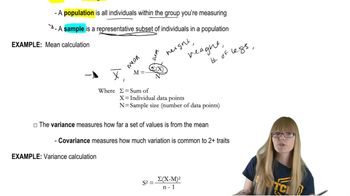New allopolyploid plant species can arise by hybridization between two species. If hybridization occurs between a diploid plant species with 2n = 14 and a second diploid species with 2n = 22, the new allopolyploid would have 36 chromosomes. Is it likely that sexual reproduction between the allopolyploid species and either of its diploid ancestors would yield fertile progeny? Why or why not?
Table of contents
- 1. Introduction to Genetics51m
- 2. Mendel's Laws of Inheritance3h 37m
- 3. Extensions to Mendelian Inheritance2h 41m
- 4. Genetic Mapping and Linkage2h 28m
- 5. Genetics of Bacteria and Viruses1h 21m
- 6. Chromosomal Variation1h 48m
- 7. DNA and Chromosome Structure56m
- 8. DNA Replication1h 10m
- 9. Mitosis and Meiosis1h 34m
- 10. Transcription1h 0m
- 11. Translation58m
- 12. Gene Regulation in Prokaryotes1h 19m
- 13. Gene Regulation in Eukaryotes44m
- 14. Genetic Control of Development44m
- 15. Genomes and Genomics1h 50m
- 16. Transposable Elements47m
- 17. Mutation, Repair, and Recombination1h 6m
- 18. Molecular Genetic Tools19m
- 19. Cancer Genetics29m
- 20. Quantitative Genetics1h 26m
- 21. Population Genetics50m
- 22. Evolutionary Genetics29m
21. Population Genetics
Allelic Frequency Changes
Problem 40a
Textbook Question
Divide the contents of a large bag of different-colored candies randomly and approximately equally among the members of the group. Do not pick specific candy colors, but simply empty the contents of the bag onto a table and quickly divide the pile. If you are doing this exercise by yourself, divide the contents of the bag into five piles. Have each person count the number of candies of each color in they pile and calculate the frequency of each color in the pile.
 Verified step by step guidance
Verified step by step guidance1
Step 1: Begin by emptying the contents of the bag of candies onto a flat surface, ensuring all candies are visible and accessible.
Step 2: Randomly divide the candies into approximately equal piles. If working alone, divide the candies into five piles. Avoid selecting candies based on color; focus on equal distribution.
Step 3: Assign each person (or yourself, if working alone) one pile of candies. Count the number of candies of each color in their respective pile. Record these counts for each color.
Step 4: Calculate the frequency of each candy color in the pile by dividing the count of candies of a specific color by the total number of candies in the pile. Use the formula:
Step 5: Repeat the frequency calculation for each candy color in the pile and compare the frequencies across different piles to observe any patterns or variations.
 Verified video answer for a similar problem:
Verified video answer for a similar problem:This video solution was recommended by our tutors as helpful for the problem above
Video duration:
1mPlay a video:
Was this helpful?
Key Concepts
Here are the essential concepts you must grasp in order to answer the question correctly.
Random Sampling
Random sampling is a technique used to select a subset of individuals from a larger population, ensuring that each member has an equal chance of being chosen. This method helps to minimize bias and allows for a more accurate representation of the population's characteristics. In the context of dividing candies, random sampling ensures that the distribution of colors is not influenced by personal preferences.
Recommended video:
Guided course

Non-Random Mating
Frequency Distribution
Frequency distribution is a statistical method that shows how often each value occurs in a dataset. It is typically represented in a table or graph, allowing for easy visualization of the data. In this exercise, calculating the frequency of each candy color helps to understand the diversity and abundance of colors in the sample, providing insights into the overall composition of the bag.
Recommended video:
Guided course

Natural Selection
Proportional Representation
Proportional representation refers to the idea that the distribution of items (like candies) should reflect the overall composition of the original group. When dividing the candies, it is important that each pile represents the variety and quantity of colors found in the entire bag. This concept is crucial for ensuring that each participant receives a fair and representative sample of the candies.
Recommended video:
Guided course

Mathematical Measurements
Related Videos
Related Practice
Textbook Question
444
views


